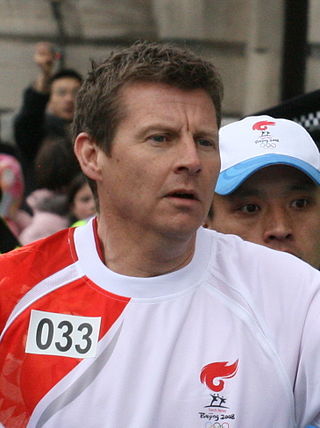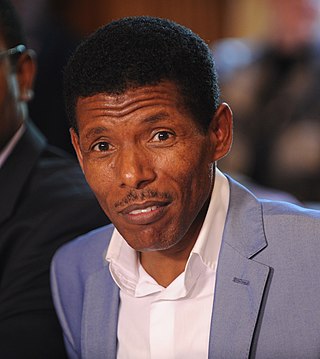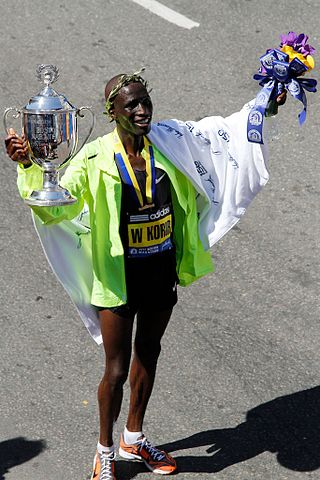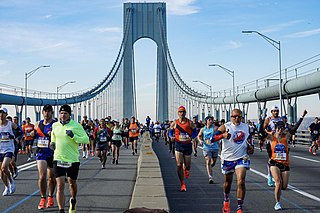
In sports, racing is a competition of speed, in which competitors try to complete a given task in the shortest amount of time. Typically this involves traversing some distance, but it can be any other task involving speed to reach a specific goal.

Stephen Cram, is a British retired track and field athlete. Along with fellow Britons Sebastian Coe and Steve Ovett, he was one of the world's dominant middle distance runners during the 1980s. Nicknamed "The Jarrow Arrow", after his home town, Cram set world records in the 1,500 m, 2,000 m, and the mile during a 19-day period in the summer of 1985. He was the first man to run 1,500 m under 3 minutes and 30 seconds. He won the 1,500 m gold medal at the 1983 World Championships and the 1,500 m silver medal at the 1984 Olympic Games.

Stephen Michael James Ovett, is a retired British track athlete. A middle-distance runner, he was the gold medalist in the 800 metres at the 1980 Olympic Games in Moscow. Ovett set five world records for 1500 metres and the mile run, and a world record at two miles. He won 45 consecutive 1500 and mile races from 1977 to 1980.

Filbert Bayi Sanka is a Tanzanian former middle-distance runner who competed throughout the 1970s. He set the world records for 1500 metres in 1974 and the mile in 1975. His world record in the 1500 m was also the Commonwealth Games record until 2022.

Paul Kibii Tergat is a Kenyan former professional long distance runner. He became the first Kenyan man to set the world record in the marathon in 2003, with a time of 2:04:55, and is regarded as one of the most accomplished long-distance runners of all time. Runnerworld called him the "Most comprehensive runner of all time".

Haile Gebrselassie is an Ethiopian former long-distance track, road running athlete, and businessman. He won two Olympic gold medals and four World Championship titles over the 10,000 metres. Haile triumphed in the Berlin Marathon four times consecutively and also had three straight wins at the Dubai Marathon. He also earned four world titles indoors and was the 2001 World Half Marathon Champion.

The Men's marathon at the 2004 Summer Olympics took place on August 29 in the streets of Athens, Greece where one hundred and one athletes from 59 nations competed. The event was won by Stefano Baldini of Italy, the nation's first victory in the event since 1988 and second overall. The United States reached the podium in the event for the first time since 1976 with Meb Keflezighi's silver. Vanderlei de Lima took bronze, Brazil's first-ever medal in the men's marathon.

Evans Rutto is a Kenyan long-distance runner, who specialises in road running events. He made the fastest-ever marathon debut by winning the 2003 Chicago Marathon in a time of 2:05:50. He won the London Marathon and a second title in Chicago the following year.

Benjamin Wabura Jipcho was a track and field athlete from Kenya, who won the silver medal in the 3000 metres steeplechase at the 1972 Summer Olympics, behind teammate Kipchoge Keino.
Sammy Korir is a long distance runner from Kenya.
Thomas Joseph Byers, Jr. is a former professional distance runner and current businessman. In 1981, when running as a designated pacemaker or 'rabbit' in the high-profile 1500 meters race at the Bislett Games in Oslo, he won against a field including Olympic champion and world record holder Steve Ovett, after the rest of the field refused to follow his early pacesetting.

Peninah Arusei Jerop is a Kenyan professional long-distance runner who specialises in road running competitions, especially the half marathon. She has represented Kenya at the Olympics, having competed in the 10,000 metres race at the 2008 Beijing Olympics. Arusei has won races on the European road circuit, including the Dam tot Damloop, Berlin Half Marathon and Lisbon Half Marathon.
Jonathan Kosgei Kipkorir is a Kenyan long-distance runner who competes in road running competitions, including marathons. He is a two-time winner of the Venice Marathon, with consecutive wins in 2006 and 2007, and won the 2010 Beppu-Ōita Marathon. He also competes over the half marathon and has wins from the Rome-Ostia Half Marathon and Porto Half Marathon. His personal best in the marathon is 2:07:31 while he has run 1:00:19 for the half marathon distance.

The 2011 Chicago Marathon was the 34th edition of the annual marathon race in Chicago, Illinois which was held on Sunday, October 9. The men's race was won by Kenya's Moses Mosop in a time of 2:05:37 hours – a course record. Ejegayehu Dibaba, making her marathon distance debut, was the women's winner in 2:22:09. Some 37,400 runners started the event and the final total of 35,670 finishers was the second highest in its history.

Wesley Kipchumba Korir is a Kenyan athlete who specializes in long distance running competitions, as well as a politician who served as an elected member of Parliament for Cherangany Constituency. On 16 April 2012, he won the Boston Marathon with a time of 2 hours 12 minutes 40 seconds. He had previously won the Los Angeles Marathon in 2009 and 2010, the first back-to-back winner there in eight years. He took second place in the 2011 Chicago Marathon in a personal-record time of 2 hours 6 minutes 15 seconds, and improved that personal record by 2 seconds in the 2012 Chicago Marathon. In the 2013 Kenyan general election, Korir was elected to a seat in the National Assembly. He lost his seat in 2017.

The 2012 Boston Marathon took place in Boston, Massachusetts on Monday April 16, 2012. It was the 116th edition of the mass-participation marathon. Organized by the Boston Athletic Association, it was the first of the World Marathon Majors series to be held in 2012. A total of 22,426 runners started the race. The competition was held in hot running conditions, reaching 88 °F (31 °C) that afternoon, and some of the 27,000 registered runners opted to take up the organizers' offer to defer their entry until the 2013 race.
The 2004 London Marathon was the 24th running of the annual marathon race in London, United Kingdom, which took place on Sunday 18 April. The race was the coldest London Marathon in history, and the wettest race in history until it was surpassed in 2020.

The 2021 New York City Marathon, the 50th running of that city's premier long-distance race, was held on November 7, 2021. Around 30,000 people ran in the event, of whom 25,020 finished. The race followed its traditional route, which passes through all five boroughs of New York City.
The 2022 London Marathon was the 42nd running of the annual London Marathon on 2 October 2022. Due to the COVID-19 pandemic the race was postponed from April until October to maximise the chances of a mass participation event. The elite men's and women's event were won by Kenyan Amos Kipruto and Ethiopian Yalemzerf Yehualaw respectively. The wheelchair races were won by Swiss athletes Marcel Hug and Catherine Debrunner respectively, both in course record times. Over 40,000 people finished the mass participation event.

He Jie is a Chinese athlete from Pingluo County. He competes in long-distance running.
















